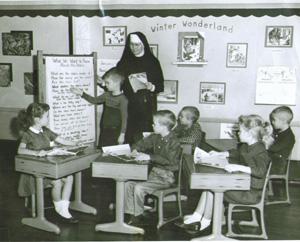
By Anne Marie Amacher
Since the late 1800s, St. Vincent’s Center has served as home in a variety of capacities from an orphanage and school to helping adolescents and serving the people of the Diocese of Davenport.
The Sisters of Humility took over Sacred Heart Asylum, an orphanage, located elsewhere in Davenport in 1896. When the Humilities came to the asylum, there were 35 children, according to “Development of Child Care, Diocese of Davenport.”
The site at which the asylum was located was too small, so the Sisters bought 10 acres of land on North Gaines Street. Bishop Henry Cosgrove assisted the Sisters in raising money by issuing an appeal to clergy, which was shared with the people of the diocese.
From then on, a collection was held yearly throughout the diocese to help fund St. Vincent’s Home, according to Catholic Messenger articles.
The cornerstone for St. Vincent’s Home was laid on July 18, 1896. The new orphanage opened Nov. 4, 1897. The cost to build the 65- by 90-foot, three-story building was $15,000.
“Development of Child Care, Diocese of Davenport” states the building included steam heat, sanitary plumbing, electric lights and “all the modern improvements.”
The first floor housed the kitchen, refectory and classrooms. The second floor included parlors, reception room, Sisters’ assembly hall and chapel. Third floor contained sleeping apartments.
According to incorporation papers, the function of St. Vincent’s Home was to provide relief and care for children temporarily or permanently made homeless or friendless.
By 1901 there were 80 children in care of the Sisters at the home. The board decided an addition should be built. In 1902 that addition was finished and another 50 acres of land was purchased. That addition cost $10,000.
This new wing was 69 by 64 feet. First floor housed the laundry room, Sisters’ work room, reception room and large play room for little girls. Second floor included a large assembly room, dormitory for boys, boys’ play room and shower/ baths. Third floor had two dormitories for girls, three bathrooms and several apartments for Sisters.
That year the Sisters transferred ownership of St. Vincent’s to the diocese. But the amended articles of incorporation were not filed until 1917. The Sisters continued to manage the home, according to Response, a publication of the Sisters of Humility.
Remodeling of St. Vincent’s Home took place over the years. By 1928, St. Vincent’s Home included 65 acres of land.
In 1929, a study of St. Vincent’s Home was conducted at the request of Msgr. Martin Cone and completed by Mabel Mattingly under the auspices of the Social Action Department, National Catholic Welfare Council.
The report critiqued the facility in areas such as population, social records, health, religion, buildings and grounds and more. In January 1928, 142 children were in the Sisters’ care; by January 1931, just 72. The reduction was attributed to the study, which stated the facility was overcrowded and that many children actually had homes in the area.
Ethel Garside, a social worker with the Bureau of Catholic Charities, aimed to make changes as suggested by the report.
A new boiler house and laundry and heating plant were added in 1929. Floor arrangements changed as space was freed up, furnishings were more colorful and comfortable and other changes were made.
Marycrest College established a laboratory school in 1939 at St. Vincent’s Home. Children from Davenport, who were not residents of the orphanage, were allowed to attend the school, according to Response.
The “History of St. Vincent’s Home,” a flier the diocese printed, states that a diocesan-wide drive was held to raise $175,000 to build a boys’ dormitory and gymnasium, which were opened in 1947. That dorm was called Martin Hall. A second fundraising drive was to raise $150,000 to build a girls’ dormitory, completed in 1950. That hall was named Marian Hall.
Due to changes in state requirements, St. Vincent’s School closed in 1969. The building was then used to care for delinquent adolescents beginning in 1970.
According to a Catholic Messenger article in 1972, financing was secured to make $80,000 in improvements to the building. St. Vincent’s Home for Adolescents was closed in 1973 “due to changing social work attitudes, increasing operation costs and an inability to provide needed subsidies,” according to a Messenger article.
The diocese acquired St. Vincent’s Home and corporation in 1973 for $1, assuming a debt of about $76,000.
At that time, remodeling was undertaken to make office space available and to provide living quarters for retired priests. The diocese consolidated its offices into St. Vincent’s Center over a period of time. The social action department moved into St. Vincent’s Center in May 1973. Religious education offices moved in August 1974, followed by other departments.
In 1982 the Sisters of Humility built their new motherhouse next door to St. Vincent’s Center on land owned by the diocese. The Sisters leased the land from the diocese.
St. Ambrose University in Davenport purchased all 58 acres of the diocesan property, including St. Vincent’s Center, for $3.35 million in July 2009. The purchase was approved by the U.S. Bankruptcy Court as part of the diocese’s bankruptcy settlement with victims of clergy sex abuse.
The Sisters of Humility and Diocese of Davenport purchased 10 acres from the university in 2010.
Renovations of St. Vincent’s Center and the construction of third-floor offices began in 2009 and were completed in early 2011.








